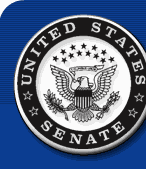
| TOPICS | |||
|

|
|||||||||||||
|
|
|
|
| Your Government |
| The
US Government is divided into three branches - legislative,
executive, and judicial.
Legislative
Branch Each state gets two Senators, so Chuck is one of one hundred Senators. Each state is divided into a number of districts according to its population. Before he was elected to the Senate, Chuck was the representative in the House of Representatives for New York's Ninth Congressional District in Brooklyn and Queens. Congress' main job is to pass laws for the United States. A law begins as a bill written by a representative or a Senator. It first goes to a committee, which is much smaller than either the Senate or the House as a whole. The members of the committee hold hearings to learn more about the issue and may change the bill. Next they take a vote, and if the bill passes it goes to either the entire House or the entire Senate depending on whether it was written by a Senator or a Representative. If it passes, the bill then goes to the other half of the Congress for a vote. If they pass the bill, then the President must decide to sign it into law or to veto it. If the President vetoes the bill, the Congress can vote to override the President's veto, but this requires the votes of two-thirds of the members of both houses. In addition, the Senate must vote on the President's choices for who should be federal judges and for other important jobs in the federal government like the Attorney General or Ambassadors to foreign countries. The Constitution says that these choices — called "nominations" — must be made with "the advice and consent" of the Senate. After the President nominates someone, the Senators vote whether or not to allow the person to have the job. This process is known as "confirmation." Agreements and treaties that the President makes with the leaders of other countries also must be voted on by the Senate. Executive
Branch The President is allowed to veto bills passed by the Congress which prevents them from becoming laws. He also decides who should be in charge of the different parts of the government. The most important officials in the government form the Cabinet which advises the President. The President is also responsible for representing the United States in foreign countries and making agreements with the leaders of those countries. He is Commander in Chief of America's military forces — the Army, Navy, Air Force, and Marines — meaning that he gives orders to the top Generals and Admirals in the different parts of the military. The Congress, however, is the only part of the government that can declare war against another country. Judicial Branch |